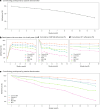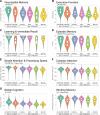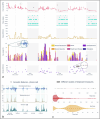Smartwatch- and smartphone-based remote assessment of brain health and detection of mild cognitive impairment
- PMID: 40038507
- PMCID: PMC11922773
- DOI: 10.1038/s41591-024-03475-9
Smartwatch- and smartphone-based remote assessment of brain health and detection of mild cognitive impairment
Abstract
Consumer-grade mobile devices are used by billions worldwide. Their ubiquity provides opportunities to robustly capture everyday cognition. 'Intuition' was a remote observational study that enrolled 23,004 US adults, collecting 24 months of longitudinal multimodal data via their iPhones and Apple Watches using a custom research application that captured routine device use, self-reported health information and cognitive assessments. The study objectives were to classify mild cognitive impairment (MCI), characterize cognitive trajectories and develop tools to detect and track cognitive health at scale. The study addresses sources of bias in current cognitive health research, including limited representativeness (for example, racial/ethnic, geographic) and accuracy of cognitive measurement tools. We describe study design and provide baseline cohort characteristics. Next, we present foundational proof-of-concept MCI classification modeling results using interactive cognitive assessment data. Initial findings support the reliability and validity of remote MCI detection and the usefulness of such data in describing at-risk cognitive health trajectories in demographically diverse aging populations. ClinicalTrials.gov identifier: NCT05058950 .
© 2025. The Author(s).
Conflict of interest statement
Competing interests: The following authors are employed by Apple, Inc.: P.M.B., J.Y., M.H., P.S., S.M., H.H.S., N.S., M.T.B., H.L., H.P. and M.P. The following authors are employed by Biogen, Inc.: P.M.B., R.B., M.H., A.B., J.P.-A., G.C., A.J., P.S.-C., D.R., A.S., G.D., A.G., R.H., S.B. J.B.L. is a full-time employee of Banner Health. Banner Alzheimer’s Institute receives funding from Eli Lilly for its collaborative partnership on TRAILBLAZER-ALZ 3; she reports receiving grants from the NIA unrelated to this project. A.P.P. has received personal fees from Acadia Pharmaceuticals, Athira, BMS, Cognitive Research Corp, IQVIA, Lundbeck, Novartis, ONO Pharmaceuticals, Otsuka, WCG, WebMD and Xenon, and grants to institution from Athira, Biogen, Cassava, Eisai, Eli Lilly, Genentech/Roche, Vaccinex, NIA, NIMH and DOD; he is a member of the Scientific Advisory Board of Alzheon, Athira, and Cognition Therapeutics. Y.T.Q. serves as consultant for Biogen on other unrelated projects. R.A. serves as scientific advisor to Signant Health and NovoNordisk. M.G.E., J.B.L., J.H.L., P.P., Y.T.Q., S.J.S., M.S., A.P.P. and R.A. all served as consultants to Biogen, Inc. on this project as members of the Intuition Study Scientific Committee.
Figures














References
-
- Stroud, C. B., Davila, J. & Moyer, A. The relationship between stress and depression in first onsets versus recurrences: a meta-analytic review. J. Abnorm. Psychol.117, 206–213 (2008). - PubMed
-
- Adib, F., Mao, H., Kabelac, Z., Katabi, D. & Miller, R. C. Smart homes that monitor breathing and heart rate. In Proc. 33rd Annual ACM Conference on Human Factors in Computing Systems (eds Begole, B & Kim, J.) 837–846 (Association for Computing Machinery, 2015).
-
- Baumeister, H. & Montag, C. Digital Phenotyping and Mobile Sensing (Springer International Publishing, 2019).
Publication types
MeSH terms
Associated data
Grants and funding
LinkOut - more resources
Full Text Sources
Medical

